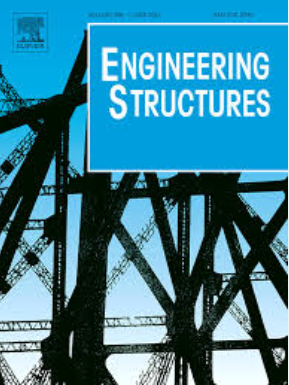考虑几何非线性的柔性索撑光伏系统气动响应计算方法
IF 6.4
1区 工程技术
Q1 ENGINEERING, CIVIL
引用次数: 0
摘要
提出了一种考虑三自由度几何非线性的双索柔性光伏系统的空气静力响应计算方法。此外,还推导出了一套确定非线性固有振动频率的方程。方程假定忽略索力随振动幅值的变化。提出了基于迭代算法的计算方法的数值计算过程,并通过气动弹性试验对计算方法进行了验证。在此计算方法的基础上,进一步分析了风速和结构参数(跨度、初始倾角、两索间距、初始预应力)对两索支撑FPV系统在静压作用下的气动响应和结构稳定性的影响。分析结果表明,风速和跨度的增大会显著增加双索支撑FPV系统的静压响应,降低结构在静压作用下的稳定性。随着风速的增大,结构稳定性最差处对应的初始倾斜角逐渐减小。增大两索之间的距离和初始预应力可以显著降低FPV系统的气动响应,增加FPV系统在气动效应下的扭弯频率比,从而增强结构的稳定性。增大两索之间的距离可以减小FPV系统的静压扭转角,增大初始预应力可以减小FPV系统的静压挠度。这两项措施可以有效提高FPV系统的抗风性能,使其面临更高的设计风速、更大的跨度和更不利的初始倾斜角。本文章由计算机程序翻译,如有差异,请以英文原文为准。
Calculation method for the aerostatic response of flexible cable-supported photovoltaic system considering geometric nonlinearity
This study presents a calculation method for the aerostatic response of a flexible photovoltaic (FPV) system supported by two cables considering geometric nonlinearity in three degrees of freedom. Additionally, a set of equations was derived to determine the nonlinear natural vibration frequency. The equations assume that the variation in cable force depending on vibration amplitude is ignored. The numerical calculation process of the calculation method based on the iterative algorithm was proposed, and the calculation method was verified through aeroelastic tests. Based on this calculation method, the effects of wind speed and structural parameters (span, initial tilt angle, distance between two cables, and initial prestress) on the aerostatic response and the structural stability of the FPV system supported by two cables under the aerostatic effects are further analyzed. The analysis results show that increases in wind speed and span significantly increase the aerostatic response of the FPV system supported by two cables and reduce the structural stability under the aerostatic effects. The initial tilt angle corresponding to the worst structural stability gradually decreases as the wind speed increases. Increasing the distance between the two cables and the initial prestress can significantly reduce the aerostatic response of the FPV system and increase the torsional-bending frequency ratio of the FPV system under the aerostatic effects, thus enhancing the stability of the structure. Increasing the distance between the two cables can reduce the aerostatic torsion angle of the FPV system, while increasing the initial prestress can reduce the aerostatic deflection of the FPV system. These two measures can effectively improve the wind resistance performance of the FPV system, which faces higher design wind speeds, a larger span, and a less favorable initial tilt angle.
求助全文
通过发布文献求助,成功后即可免费获取论文全文。
去求助
来源期刊

Engineering Structures
工程技术-工程:土木
CiteScore
10.20
自引率
14.50%
发文量
1385
审稿时长
67 days
期刊介绍:
Engineering Structures provides a forum for a broad blend of scientific and technical papers to reflect the evolving needs of the structural engineering and structural mechanics communities. Particularly welcome are contributions dealing with applications of structural engineering and mechanics principles in all areas of technology. The journal aspires to a broad and integrated coverage of the effects of dynamic loadings and of the modelling techniques whereby the structural response to these loadings may be computed.
The scope of Engineering Structures encompasses, but is not restricted to, the following areas: infrastructure engineering; earthquake engineering; structure-fluid-soil interaction; wind engineering; fire engineering; blast engineering; structural reliability/stability; life assessment/integrity; structural health monitoring; multi-hazard engineering; structural dynamics; optimization; expert systems; experimental modelling; performance-based design; multiscale analysis; value engineering.
Topics of interest include: tall buildings; innovative structures; environmentally responsive structures; bridges; stadiums; commercial and public buildings; transmission towers; television and telecommunication masts; foldable structures; cooling towers; plates and shells; suspension structures; protective structures; smart structures; nuclear reactors; dams; pressure vessels; pipelines; tunnels.
Engineering Structures also publishes review articles, short communications and discussions, book reviews, and a diary on international events related to any aspect of structural engineering.
 求助内容:
求助内容: 应助结果提醒方式:
应助结果提醒方式:


